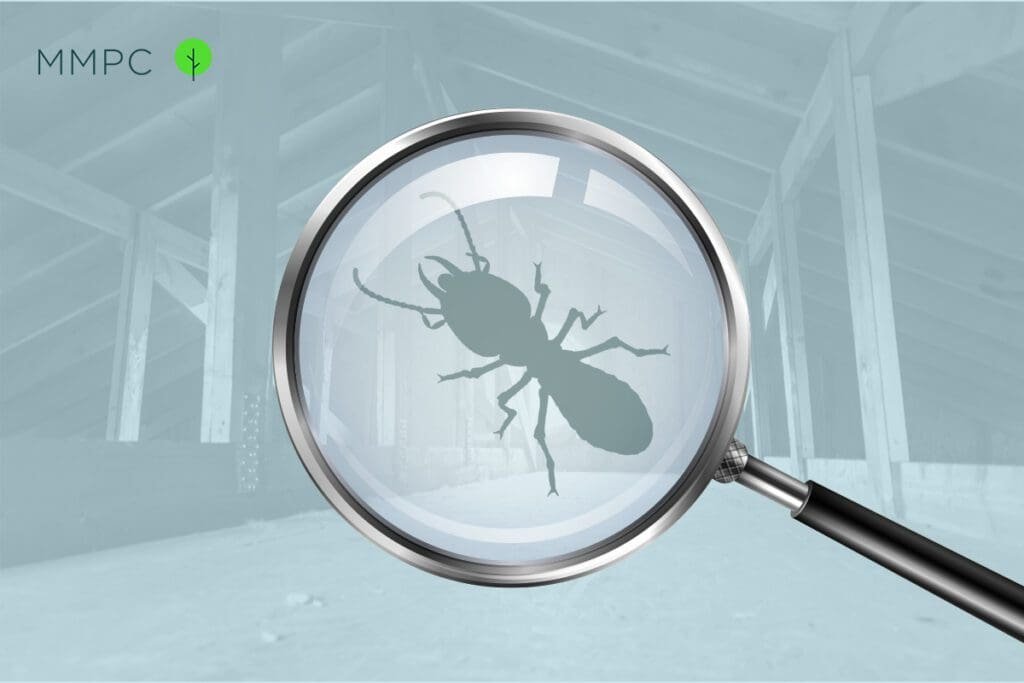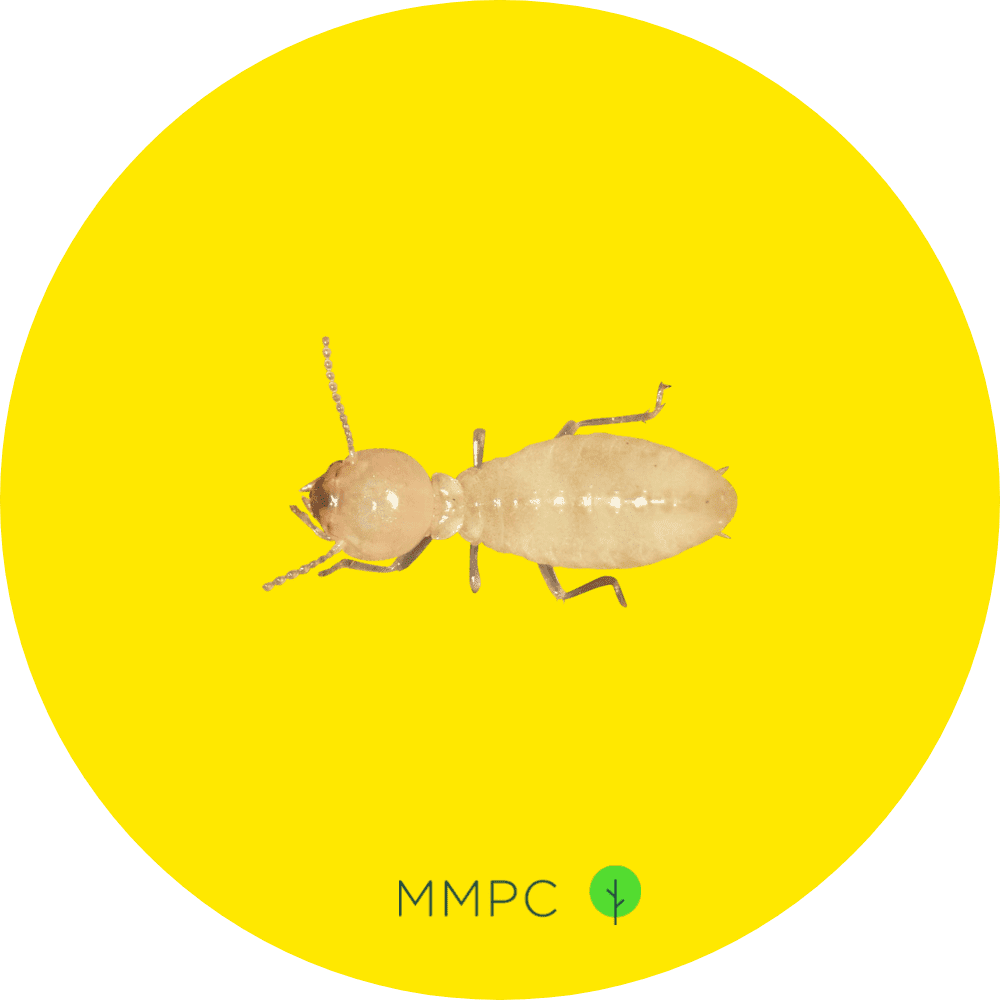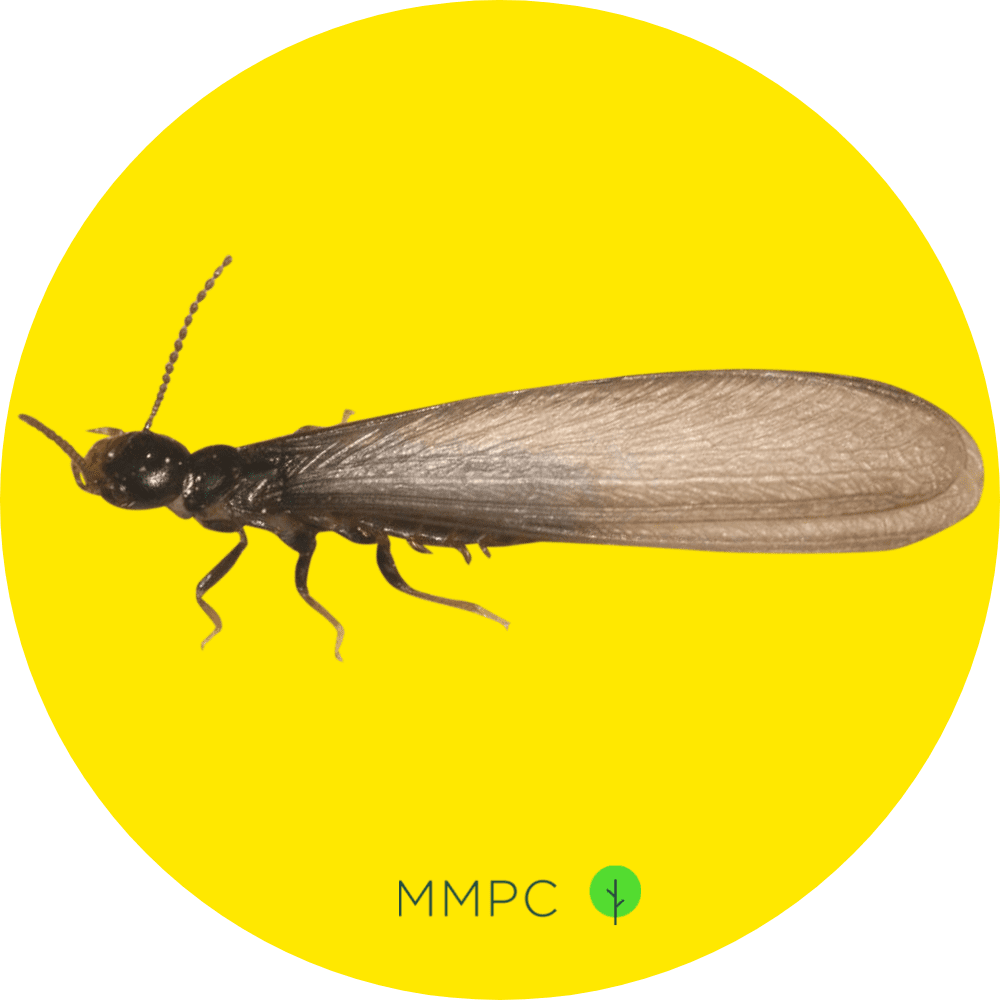
Termites are a challenging pest problem to detect, especially for new homeowners who aren’t familiar with what termites look like.
These small, ant-like insects with big heads and large mandibles can cause destructive and costly amounts of structural damage to your home and property if not found and dealt with.
Knowing what termites look like and understanding their defining characteristics can help you detect and recognize an infestation early on. Read this article to learn about the most common types of termites to watch out for.
If you’re seeing insects that you suspect are termites, it’s worth your while to get a professional inspection.
In fact, it’s recommended that all homeowners get a yearly termite inspection (also known as a Wood Destroying Insect Inspection).
What Do Termites Look Like?
While their appearance varies from species to species, here are some common characteristics that help distinguish termites from other insects:
- Small insects around 1/8–1/2 inch long
- 2 protruding mandibles (jaws)
- 2 straight antennae composed of round, bead-like segments
- 6 thin, spindly legs that are slightly transparent
- Soft bodies with a thick thorax (waist)
- Coloration ranges from pale yellow to dark brown
Termite colonies have 3 main castes, or roles: workers, soldiers, and reproductives (also known as “alates” or “swarmers”). Each caste has a unique appearance—especially termite swarmers, which have wings and are often confused with flying ants.
Types of Termites in New York
The only species of termites native to New York is the eastern subterranean termite (Reticulitermes flavipes) .
Outside of New York, the 2 most prevalent types of termite species in the United States are subterranean termites and drywood termites.
Drywood termites are only found in a narrow strip along the southern United States, from Florida to California. Although they’re not established in New York, they can sometimes be inadvertently brought into homes here inside of infested furniture and wooden objects.
Other types of termite species include dampwood termites, Formosan termites, and conehead termites.
But in this article, we’ll describe the appearance of each type of termite species:
- What do subterranean termites look like?
- What do drywood termites look like?
- What do Formosan termites look like?
- What do dampwood termites look like?
- What do conehead termites look like?

What Do Subterranean Termites Look Like?
Subterranean termites are named for their tendency to nest underneath the soil, rather than inside of wood. They’re by far the most destructive termite species in the United States.
Compared to drywood termites, subterranean termites are typically smaller in size. An average subterranean termite soldier measures approximately 1/8 inch long, while an average drywood termite soldier can grow up to 3/8 inch long.
You can also identify subterranean termites by their distinctive mud tubes, which are narrow tunnels leading from the soil to their food sources.
Subterranean termites build these mud tubes to protect themselves from predators and from drying out. They look like long, winding patches of dried dirt, and can usually be found along the surface of walls or inside cracks and crevices.
Subterranean Termite Workers
Subterranean termite workers have pale, cream-colored bodies that typically grow to be around 1/8 inch long. They have 6 short and pale legs, 2 small mandibles, and straight antennae.
Workers make up the vast majority of a termite colony, and they belong to the lowest class—they’re sterile, blind, and basically spend 24 hours a day working.
Subterranean Termite Soldiers
Subterranean termite soldiers are slightly larger than workers, and can be identified by their big, somewhat rectangular-shaped heads that look disproportionally large relative to their bodies.
Their heads are a darker shade of orange-brown that stands out from the rest of their pale bodies, with long, black-colored, pincer-like mandibles that they use to fight with enemies.
You can tell a subterranean termite soldier apart from a drywood termite soldier by the size of its protonum (the armored segment directly behind the head). Subterranean termites look a bit like bobbleheads with narrow protona, while drywood termites have protona that are wider than their heads.
Subterranean Termite Swarmers
Termite swarmers are the reproductive members of a termite colony, responsible for emerging each spring to find mates and establish new colonies. They have large wings capable of flight, and may resemble flying ants.
Subterranean termite swarmers have solid black bodies and translucent wings, and are much smaller than drywood termite swarmers.
At maturity, they reach approximately 3/8 inch in length from their mandibles to the tips of their long, translucent wings. Each swarmer has two pairs of wings (four wings total) that are of equal length and about twice as long as their body.
Swarmers shed their wings prior to mating, so in the spring you might find piles of discarded wings near doors and windows.

What Do Drywood Termites Look Like?
Drywood termites make their nests deep inside wooden objects and structures. Unlike subterranean termites and dampwood termites, drywood termites don’t require much moisture to survive, which allows them to thrive in hot, dry climates.
While subterranean termites are known for their mud tubes, drywood termites are instead known for their frass, or droppings, which come in the form of tiny, six-sided pellets that look like sawdust or coffee grinds. Drywood termites have a unique habit of leaving their fecal matter in piles near areas where they’re active.
There are several species of drywood termites that homeowners outside of New York should be wary of. The most common ones are western drywood termites (Incisitermes minor), which are dominant in the southwestern United States; southeastern drywood termites (Incisitermes snyderi), which are widely distributed across southeastern states from Texas to South Carolina; and West Indian drywood termites (Cryptotermes brevis), primarily found in Florida, Hawaii, Puerto Rico, and the southeastern Gulf Coast.
Drywood Termite Workers
Unlike other species of termites, drywood termites don’t have true “workers.” Instead, immature termites called “pseudergates” (or “pseudo-workers”) fill the role of workers within the colony. The main difference between pseudergates and true workers is that the pseudergates are not sterile and may continue to develop into reproductive alates (swarmers) when the need arises.
Appearance-wise, pseudergates look very similar to subterranean termite workers — soft, cream-colored bodies with short legs, small mandibles, and straight antennae. It can be quite difficult to tell them apart because drywood termite pseudergates come in many sizes.
In most drywood species, like the western drywood termite, pseudergates are usually larger than subterranean termite workers. But in some species, like the West Indian drywood termite, pseudergates may be smaller.
Drywood Termite Soldiers
Drywood termite soldiers have large, rectangular, reddish-brown heads and two black-colored mandibles with two prominent teeth visible on the inside edges. Behind the head is a wide-plated protonum, which is a feature that is often used to identify them apart from subterranean termites soldiers.
They are also much bigger than their subterranean counterparts. In terms of size, drywood termite soldiers can grow to be quite large in mature termite colonies, ranging from 3/8 to 1/2 inch in some species.
Different species of drywood termites also have unique features. Soldiers of the West Indian drywood termite have squarish, brownish-black heads that contrast sharply against their pale bodies, making them like burnt matchsticks.
Western drywood termite soldiers have interesting antennae with an enlarged club-like 3rd antennal segment that’s thicker and longer than the other bead-like segments.
Drywood Termite Swarmers
Drywood termite swarmers are larger than those of the subterranean termite species. They typically measure around 1/2 inch long, with yellow to brown-colored bodies and two sets of long, equally-sized wings.
You can identify western drywood termite swarmers by their orange-brown heads, dark brown bodies, and smoky-colored wings. In comparison, West Indian and southeastern drywood termite swarmers have light brown or yellow bodies and clear, transparent wings.
Interestingly, drywood termite swarmers have veiny wings with a reflective, iridescent surface that resembles oil on water. By contrast, subterranean termite swarmers’ wings are dull and less veiny.

What Do Formosan Termites Look Like?
Formosan termites (Coptotermes formosanus) were originally native to Taiwan and southern China, but can now be found invading homes in the southeastern United States.
Nicknamed the “super termite,” Formosan termites are known for their large colonies. A single Formosan colony can span 300 feet with anywhere from 1–10 million termites. This extreme population size is what makes Formosan termites so destructive. In severe infestations, they can hollow out wooden structures completely, leaving only a paper-thin surface.
Formosan termites can be considered a type of subterranean termite, as they establish their main colonies in the ground rather than wood and create mud tubes when foraging.
But unlike subterranean termites, Formosan termites also establish smaller satellite colonies called “aerial” colonies that aren’t connected to the ground (such as inside the flat roofs of buildings where rainwater frequently pools).
Formosan Termite Workers
Formosan termite workers have off-white or cream-colored bodies that are hard to distinguish from other termite species. Like drywood termites, Formosan termite workers are also referred to as pseudergates.
Formosan Termite Soldiers
Formosan termite soldiers are similar in size to subterranean termite soldiers, measuring between 1/8–1/4 inch long.
In terms of appearance, Formosan termite soldiers have orange-brown heads with curved, black mandibles. They can be identified by the oval or tear-drop shape of their heads, unlike the rectangular heads of subterranean and drywood termite soldiers.
Soldiers typically only make up 1–2% of the population in a subterranean termite colony, but they make up 10–15% in a Formosan termite colony. If you see a termite infestation with a significant number of soldiers, that can be a clue that points to Formosan termites.
Formosan Termite Swarmers
Formosan termite swarmers grow to be around 1/2–5/8 inch in length, which is larger than the average subterranean termite swarmer. They have yellowish-brown bodies and clear wings with a dense covering of small hairs.

What Do Dampwood Termites Look Like?
Dampwood termites are the largest species of termites in the United States. They are mainly found in states with tropical, high-humidity climates. Despite their size, dampwood termites are considered less destructive than other termite species because their colonies are relatively small, numbering only in the thousands.
Unlike drywood termites, dampwood termites can’t survive in dry wood. Instead, they make their homes in moist, decaying wood and require a constant water supply.
Dampwood termite infestations tend to be more difficult to detect because they don’t create mud tubes or visible holes in wood. In fact, they plug any holes with their own fecal matter to prevent themselves from drying out.
There are two common species of dampwood termites: Pacific dampwood termites (Zootermopsis angusticollis), which are endemic to states along the pacific coast, and Florida dampwood termites (Neotermes castaneus), which are endemic to Florida, Hawaii, Puerto Rico, and the Virgin Islands.
Dampwood Termite Workers
Dampwood termites also have pseudergates instead of true workers. Pseudergates are immature termites that fill the role of workers but are not sterile and may develop into alates (swarmers) if the need arises.
Dampwood termite pseudergates resemble those of drywood termites except they’re much larger, with some reaching sizes of up to 1/2 inch long.
Dampwood Termite Soldiers
Dampwood termite soldiers have large, flat, rectangular heads that are dark and reddish-brown in color. Their mandibles are black with at least two marginal teeth visible. Similar to drywood termites, the protonum is as wide as the head.
The most distinctive feature of dampwood termite soldiers is their size, which is massive compared to other species. They have large, light caramel-colored bodies that measure between 5/8–3/4 inch long (around twice the size of most drywood termite soldiers).
Dampwood Termite Reproductives (Swarmers)
Dampwood termite swarmers are usually between 1/2–5/8 inch long, although some species may reach lengths of up to 1 inch (Florida dampwood termites).
The color of their bodies can range from yellowish-brown to medium-brown. They have dark, smoky-colored wings that measure almost 1/2 inch long.

What Do Conehead Termites Look Like?
Conehead termites (Nasutitermes corniger) were first introduced to the United States in 2001 and are now found mainly in Southern Florida.
Their name comes from the unique appearance of conehead termite soldiers, which have an elongated projection on the front that makes their heads resemble cones.
Unlike subterranean and drywood termites, conehead termites build and live in nests above ground in what resembles balls of chewed wood in the grass. They also forage on the ground like ants rather than excavating and traveling through tunnels, which helps them spread quickly.
Conehead Termite Workers
Conehead termites have two sizes of workers, ranging from 1/9–1/5 inch in length. The large workers are female, while the small workers are male.
Conehead Termite Soldiers
Conehead termite soldiers are around the same size as workers, perhaps slightly smaller. They have dark brown heads with a unique, cone-shaped snout in front called the nasus, which sprays a sticky aerosol chemical used for defense.
Conehead Termite Swarmers
Unlike their soldiers, conehead termite swarmers are relatively large compared to other termite species, measuring between 5/8–3/4 inches long. They have dark brown bodies with especially dark wings.
About MMPC
If you suspect that there are termites in your home, send a picture to our Free Pest ID Center and our professional termite experts will be happy to identify it for you.
At MMPC, we have 25+ years of experience providing high quality, eco-friendly termite control services. Contact us today for help with termite inspection or removal in New York City and the Tri-State area.



